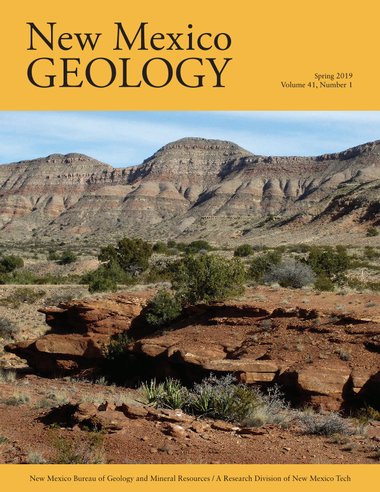
New Mexico Geology — Back-issues
Print ISSN: 0196-948X (prior to 2015)
Online ISSN: 2837-6420
Volume: 41, 2019

View as PDF (8.27 MB)
Number: 1
Full-Issue (8.27 MB PDF)
Cover Image: Loma de las Cañas
— Spencer G. Lucas
The Loma de las Cañas northeast of Socorro is a northeast-southwest oriented ridge composed of lower Permian sedimentary rocks. These are strata of the Yeso Group overlain by the Glorieta Sandstone capped by the lower part of the San Andres Formation. In the foreground, reddish brown sandstone and siltstone of the Arroyo de Alamillo Formation of the Yeso Group crop out as low benches and in gullies. The lower slope of the Loma is strata of the Torres Member of the Los Vallos Formation that are variegated beds of salmon-colored siltstone, gray gypsum and black dolomite. The prominent red beds above them are the Joyita Member of the Los Vallos Formation, and the thick gray gypsum interval below it is the Cañas Member. Above the Joyita Member, which is the uppermost unit of the Yeso Group, tabular beds of yellow and brown sandstone are the Glorieta Sandstone, and they are capped by dark gray, bedded limestones of the lower part of the San Andres Formation. In 1904, Clarence Luther Herrick (1858–1904), one of the pioneers of New Mexico geology, published the first description of the strata of the Loma de las Cañas. Herrick thought most of these strata are of Triassic and Jurassic age, but decades of subsequent research on the regional stratigraphy and biostratigraphy has firmly established their early Permian age.
Contents:
-
The Cretaceous System in central Sierra County, New Mexico (3.71 MB PDF), pp. 3-39. [View Abstract]
— Spencer G. Lucas, W. John Nelson, Karl Krainer, and Scott D. ElrickData Repository: 20190002: < http://geoinfo.nmt.edu.nmt.edu/repository/index.cfm?rid=20190002 > -
Gallery of Geology: The trace fossil Ophiomorpha from the Upper Cretaceous Trinidad Sandstone, northeastern New Mexico (1.02 MB PDF), pp. 40-43.
— Spencer G. Lucas -
New Mexico Graduate student abstracts (99.2 KB PDF), pp. 44-49.


